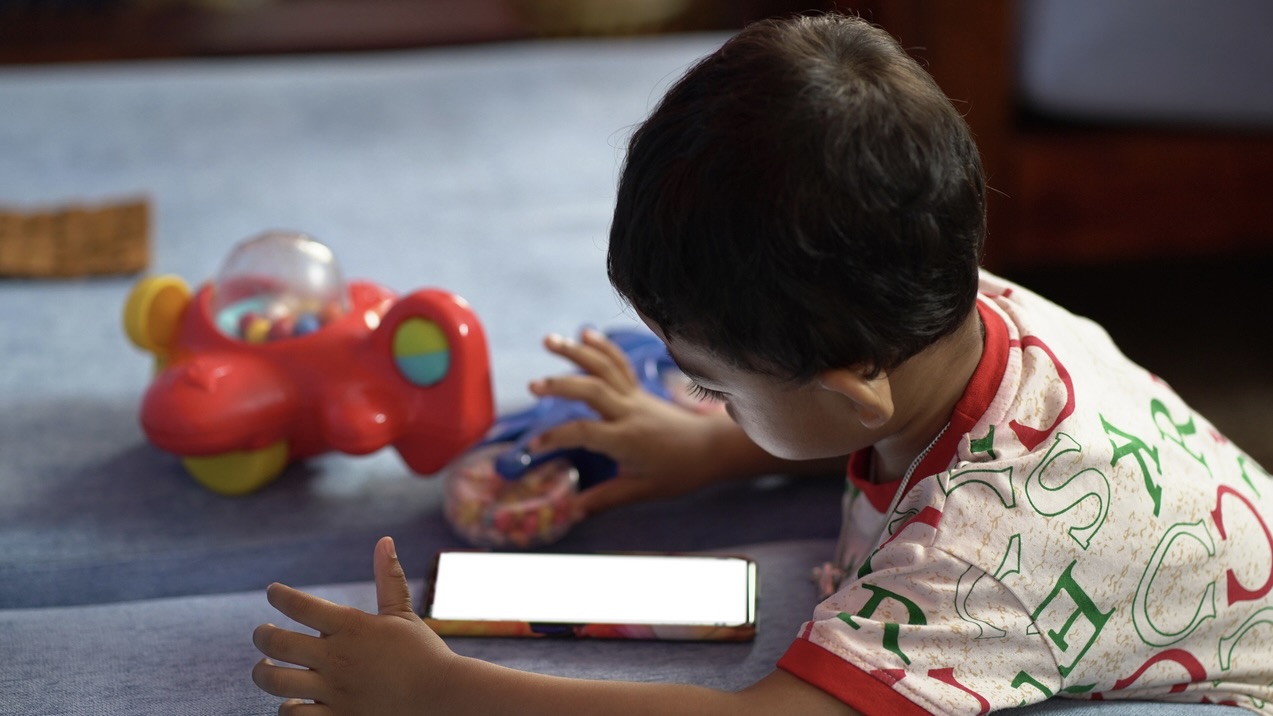By Veni E N,Veni E Npublished
Copyright thesouthfirst

‘Virtual autism’: How too much screen time may mimic autism in toddlers
Unlike autism, which is hereditary, virtual autism stems from prolonged use of phones, tablets and televisions in the first three years of life.
Synopsis: Excessive screen exposure in early childhood is linked to a condition called virtual autism, where children without a genetic basis display autism-like behaviours, including delayed speech, reduced eye contact and limited social interaction, according to Chennai-based paediatrician Dr Vigneshwari Raja. The condition, first described in 2018, arises from prolonged use of phones, tablets and televisions in the first three years of life, unlike classical autism which is hereditary.
Excessive screen exposure in early childhood is giving rise to a condition called virtual autism, where children without a genetic basis are experiencing autism-like symptoms, according to Chennai-based paediatrician Dr Vigneshwari Raja.
The term was introduced in 2018 by Romanian psychologist Marius Teodor Zamfir, after he observed autism-like behaviours in children exposed to long hours of screen time worldwide.
Unlike autism, which is hereditary, virtual autism stems from prolonged use of phones, tablets and televisions in the first three years of life.
Dr Raja, Consultant Paediatrician and Neonatologist at Apollo Cradle, Karapakkam, told South First that affected children show delayed speech, reduced eye contact and limited social interaction, patterns that have reportedly grown more pronounced since the COVID-19 pandemic.
“It is a symptom which a child develops due to excessive screen time usage,” she explained, adding that screens fail to provide the back-and-forth exchanges vital for brain development.
“Screen is a one-way communication,” she said. “Children need gestures, smiles, and conversations with caregivers.”
Also Read: New shorter, fully oral TB treatments aim to ease patient burden and improve cure rates
Warning signs in everyday milestones
The paediatrician said the impact of virtual autism is becoming increasingly visible during routine clinic visits, where a child’s development is assessed alongside vaccinations.
“By six months, a child should be saying monosyllabic sounds like ma, ba, da. By nine months, they should move to bisyllabic, like mama or dada. And by one year, the child will be turning to you or following one-step commands like ‘pick the ball’ or ‘take the towel,’ making eye contact,” she said.
She pointed out that many children are now missing these milestones, showing reduced social smiles and minimal eye contact. “They’re not making even eye contact when you come,” she noted.
Dr Raja cautioned parents against handing phones or tablets to children as pacifiers. “The first point is, never use screen as a means to distract the crying or distress the child,” she said. Her guideline for families is simple: “Less than two years, zero screen time.”
She added that restrictions are just as important for older children. “Never use screen during the meal time. And also, before one hour, before sleep,” she advised.
Also Read: Self medicating for acidity, vomiting? Doctors warn of stroke-like side effects
Building awareness among parents
Dr Raja stressed that awareness among parents, especially first-time and working parents, is the most crucial step in preventing virtual autism.
“Parents today are more aware of autism compared to three years ago, thanks to social media. But awareness has to go beyond just knowing the term, it’s about understanding the implications of excess screen time,” she said.
She explained that this awareness needs to begin at the paediatric clinic itself. “Every time a child comes for vaccination, we remind parents about the importance of zero screen time for children under two years. Just like prescribing paracetamol for fever, we keep repeating: no screens, no screens,” she noted.
The paediatrician highlighted that the first three years are the golden period for brain development, and parents must not trade this time for convenience.
“If you don’t limit screen exposure early, you may end up spending years in speech or occupational therapy later. A stitch in time saves nine,” she cautioned.
To prevent the condition, she recommended a holistic approach involving parents, caregivers, teachers and even policymakers.
This, she said, includes limiting screen time according to age, choosing age-appropriate content, encouraging physical activity, nurturing interpersonal relationships, and maintaining digital hygiene at home.
“Parents should talk, play, laugh, and spend time with their children. These moments may feel chaotic, but they are irreplaceable. If needed, hire help or consider daycare instead of handing over a phone. The priority is ensuring children engage with real people, not just screens,” Dr Raja emphasised.
Also Read: Sex toy or medical aid? Patients caught in India’s grey zone
Pandemic habits and modern family challenges
Dr Raja pointed out the hidden fallout of the pandemic, where screens often replaced playgrounds and social interaction for children confined at home.
“During the COVID period, people were held up at home. They could not go outside, take their child to the park, or get help from others. Parents also had to work from home, and screens became a rescue,” she said.
She emphasised that although lockdowns are over, families now have the opportunity to limit screen time and restore normal developmental routines.
The paediatrician explained that modern family structures have added to the challenge.
“Previously, in joint families, elder members actively participated in raising children. Today, most families are nuclear, and even if grandparents are present, they are often not engaged. This has increased reliance on phones and tablets to occupy children,” she noted.
While stressing the importance of parental role-modelling, she added, “If a parent watches TV while eating, the child will also demand screen time during meals. Parents should demonstrate healthy habits and set routines for the child.”
For families where both parents work, she advised structured support. “Get help from a nanny or consider daycare. But if someone takes care of the child, they should actively engage, not just hand over a screen,” she explained.
Physical activity is equally important, she underlined. Children over five years need at least three hours of activity: one hour of structured exercise such as classes or sports, and two hours of unstructured play.
For younger children, simple activities such as walking, running, dancing, or helping around the house support both motor and social skills.
She also highlighted the value of involving children in everyday routines.
“Children can learn while helping with simple household chores, like sorting vegetables or folding clothes. They also develop language and social skills when you talk to them throughout these activities,” she said, adding that with awareness and timely action, parents can ensure healthy growth and development for their children.



